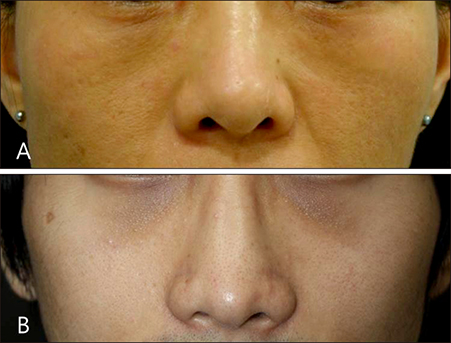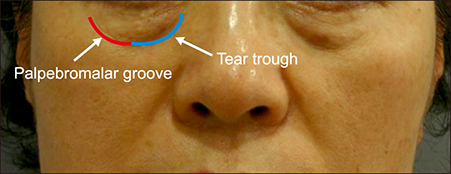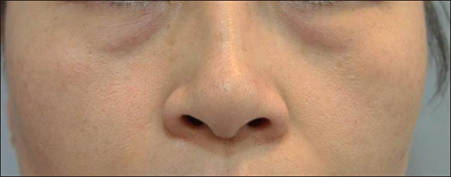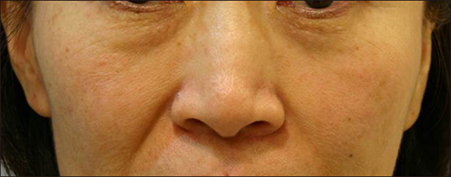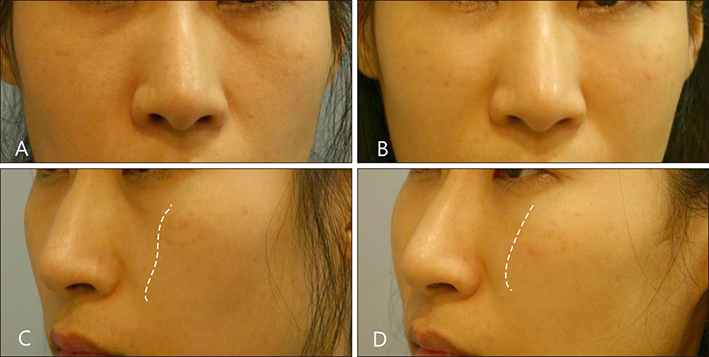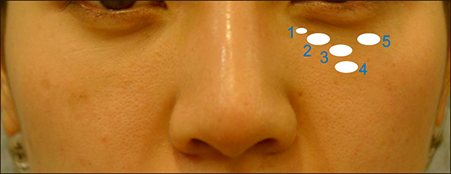Ann Dermatol.
2018 Oct;30(5):522-528. 10.5021/ad.2018.30.5.522.
Treatments of Infra-Orbital Dark Circles by Various Etiologies
- Affiliations
-
- 1Department of Dermatology, Chung-Ang University College of Medicine, Seoul, Korea. drseo@cau.ac.kr
- 2Yemiwon Dermatologic Clinic, Seoul, Korea. dermacsyoun@hanmail.net
- KMID: 2419740
- DOI: http://doi.org/10.5021/ad.2018.30.5.522
Abstract
- Dark circles refer to visible darkness of the infra-orbital areas. Dark circles are a cosmetic concern for many individuals, although not a medical concern. Moreover, clear definitions and possible causes of dark circles have not been elucidated. This study reviews the possible causes and treatment options for dark circles based on a review of the medical literature and the authors' clinical experience. Potential factors that contribute to dark circles include excessive pigmentation, shadowing due to tear troughs and infra-orbital fat herniation, shadowing due to infraorbital laxity and wrinkles, and thin, translucent skin overlying the orbicularis oculi muscle. Given the different possible causes for dark circles, therapeutic modalities must be individualized for each patient. Because various factors cause dark circles, it is useful to identify the underlying causes in order to select the appropriate treatment.
Figure
Reference
-
1. Nkengne A, Bertin C, Stamatas GN, Giron A, Rossi A, Issachar N, et al. Influence of facial skin attributes on the perceived age of Caucasian women. J Eur Acad Dermatol Venereol. 2008; 22:982–991.
Article2. Camp MC, Wong WW, Filip Z, Carter CS, Gupta SC. A quantitative analysis of periorbital aging with three-dimensional surface imaging. J Plast Reconstr Aesthet Surg. 2011; 64:148–154.
Article3. Mayes AE, Murray PG, Gunn DA, Tomlin CC, Catt SD, Wen YB, et al. Ageing appearance in China: biophysical profile of facial skin and its relationship to perceived age. J Eur Acad Dermatol Venereol. 2010; 24:341–348.
Article4. Freitag FM, Cestari TF. What causes dark circles under the eyes? J Cosmet Dermatol. 2007; 6:211–215.
Article5. Roh MR, Chung KY. Infraorbital dark circles: definition, causes, and treatment options. Dermatol Surg. 2009; 35:1163–1171.
Article6. Marks MB. Allergic shiners. Dark circles under the eyes in children. Clin Pediatr (Phila). 1966; 5:655–658.7. Haddock NT, Saadeh PB, Boutros S, Thorne CH. The tear trough and lid/cheek junction: anatomy and implications for surgical correction. Plast Reconstr Surg. 2009; 123:1332–1340. discussion 1341-1342.
Article8. Gendler EC. Treatment of periorbital hyperpigmentation. Aesthet Surg J. 2005; 25:618–624.
Article9. Park KY, Kwon HJ, Lee C, Kim D, Yoon JJ, Kim MN, et al. Efficacy and safety of a new microneedle patch for skin brightening: a randomized, split-face, single-blind study. J Cosmet Dermatol. 2017; 16:382–387.
Article10. Sharad J. Dermal fillers for the treatment of tear trough deformity: a review of anatomy, treatment techniques, and their outcomes. J Cutan Aesthet Surg. 2012; 5:229–238.
Article11. Mustak H, Fiaschetti D, Goldberg RA. Filling the periorbital hollows with hyaluronic acid gel: long-term review of outcomes and complications. J Cosmet Dermatol. 2017; [Epub ahead of print]. DOI: 10.1111/jocd.12452.
Article12. Sundaram H, Cassuto D. Biophysical characteristics of hyaluronic acid soft-tissue fillers and their relevance to aesthetic applications. Plast Reconstr Surg. 2013; 132:4 Suppl 2. 5S–21S.
Article13. Pierre S, Liew S, Bernardin A. Basics of dermal filler rheology. Dermatol Surg. 2015; 41:Suppl 1. S120–S126.
Article14. Kablik J, Monheit GD, Yu L, Chang G, Gershkovich J. Comparative physical properties of hyaluronic acid dermal fillers. Dermatol Surg. 2009; 35:Suppl 1. 302–312.
Article15. Park S, Park KY, Yeo IK, Cho SY, Ah YC, Koh HJ, et al. Investigation of the degradation-retarding effect caused by the low swelling capacity of a novel hyaluronic acid filler developed by solid-phase crosslinking technology. Ann Dermatol. 2014; 26:357–362.
Article16. Park KY, Kim HK, Kim BJ. Comparative study of hyaluronic acid fillers by in vitro and in vivo testing. J Eur Acad Dermatol Venereol. 2014; 28:565–568.
Article17. Stocks D, Sundaram H, Michaels J, Durrani MJ, Wortzman MS, Nelson DB. Rheological evaluation of the physical properties of hyaluronic acid dermal fillers. J Drugs Dermatol. 2011; 10:974–980.18. Park KY, Seok J, Ko EJ, Kim BJ, Kim MN, Youn CS. Hyaluronic acid filler combined with antioxidants for infraorbital rejuvenation: report of two cases. Dermatol Ther. 2017; 30:DOI: 10.1111/dth.12448.
Article19. Al-Shami SH. Treatment of periorbital hyperpigmentation using platelet-rich plasma injections. Am J Dermatol Venereol. 2014; 3:87–94.20. Mehryan P, Zartab H, Rajabi A, Pazhoohi N, Firooz A. Assessment of efficacy of platelet-rich plasma (PRP) on infraorbital dark circles and crow's feet wrinkles. J Cosmet Dermatol. 2014; 13:72–78.
Article21. Kim DH, Je YJ, Kim CD, Lee YH, Seo YJ, Lee JH, et al. Can platelet-rich plasma be used for skin rejuvenation? Evaluation of effects of platelet-rich plasma on human dermal fibroblast. Ann Dermatol. 2011; 23:424–431.
Article22. Kim DS, Park SH, Park KC. Transforming growth factor-beta1 decreases melanin synthesis via delayed extracellular signal regulated kinase activation. Int J Biochem Cell Biol. 2004; 36:1482–1491.23. Yun WJ, Bang SH, Min KH, Kim SW, Lee MW, Chang SE. Epidermal growth factor and epidermal growth factor signaling attenuate laser-induced melanogenesis. Dermatol Surg. 2013; 39:1903–1911.
Article24. Oh DS, Cheon YW, Jeon YR, Lew DH. Activated platelet-rich plasma improves fat graft survival in nude mice: a pilot study. Dermatol Surg. 2011; 37:619–625.
Article25. Sini P, Denti A, Cattarini G, Daglio M, Tira ME, Balduini C. Effect of polydeoxyribonucleotides on human fibroblasts in primary culture. Cell Biochem Funct. 1999; 17:107–114.
Article26. Park KY, Seok J, Rho NK, Kim BJ, Kim MN. Long-chain polynucleotide filler for skin rejuvenation: efficacy and complications in five patients. Dermatol Ther. 2016; 29:37–40.
Article27. Pak CS, Lee J, Lee H, Jeong J, Kim EH, Jeong J, et al. A phase III, randomized, double-blind, matched-pairs, activecontrolled clinical trial and preclinical animal study to compare the durability, efficacy and safety between polynucleotide filler and hyaluronic acid filler in the correction of crow's feet: a new concept of regenerative filler. J Korean Med Sci. 2014; 29:Suppl 3. S201–S209.
Article28. Xu TH, Yang ZH, Li YH, Chen JZ, Guo S, Wu Y, et al. Treatment of infraorbital dark circles using a low-fluence Q-switched 1,064-nm laser. Dermatol Surg. 2011; 37:797–803.
Article29. Sukal SA, Chapas AM, Bernstein LJ, Hale EK, Kim KH, Geronemus RG. Eyelid tightening and improved eyelid aperture through nonablative fractional resurfacing. Dermatol Surg. 2008; 34:1454–1458.
Article30. Lolis MS, Goldberg DJ. Assessment of safety and efficacy of a bipolar fractionated radiofrequency device in the treatment of periorbital rhytides. J Cosmet Laser Ther. 2014; 16:161–164.
Article31. Park KY, Oh IY, Moon NJ, Seo SJ. Treatment of infraorbital dark circles in atopic dermatitis with a 2790-nm erbium: yttrium scandium gallium garnet laser: a pilot study. J Cosmet Laser Ther. 2013; 15:102–106.
Article32. Chen DL, Cohen JL. Treatment of periorbital veins with long-pulse Nd:YAG laser. J Drugs Dermatol. 2015; 14:1360–1362.33. Ma G, Lin XX, Hu XJ, Jin YB, Chen H. Treatment of venous infraorbital dark circles using a long-pulsed 1,064-nm neodymium-doped yttrium aluminum garnet laser. Dermatol Surg. 2012; 38:1277–1282.
Article34. Grant JR, Laferriere KA. Periocular rejuvenation: lower eyelid blepharoplasty with fat repositioning and the suborbicularis oculi fat. Facial Plast Surg Clin North Am. 2010; 18:399–409.
Article35. Kim SW, Kim WS, Cho MK, Whang KU. Transconjunctival laser blepharoplasty of lower eyelids: Asian experience with 1,340 cases. Dermatol Surg. 2003; 29:74–79.
Article36. Ablon G, Rotunda AM. Treatment of lower eyelid fat pads using phosphatidylcholine: clinical trial and review. Dermatol Surg. 2004; 30:422–427.
Article37. U.S. Food and Drug Administration. FDA Information on Lipodissolve [Internet]. Silver Spring, MD: U.S. Food and Drug Administration;update 2010 Apr 7. cited 2018 Feb 6. Available from: http://wayback.archive-it.org/7993/20171115004713/https://www.fda.gov/Drugs/GuidanceComplianceRegulatoryInformation/PharmacyCompounding/ucm207624.htm.
- Full Text Links
- Actions
-
Cited
- CITED
-
- Close
- Share
- Similar articles
-
- Strategy for the Treatment of Infraorbital Dark Circles
- Correction of Dark Coloration of the Lower Eyelid Skin with Nanofat Grafting
- Clinical Characteristics of Orbital Cellulitis in Children
- Surgical approach of orbital medial wall fractures
- Penetrating Trans-Orbital Injury from a Brush Handle Lodged in the Infra-Temporal Fossa

